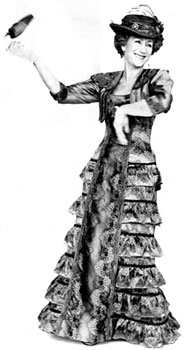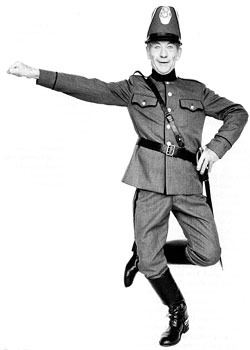 |
From
THE
NEW YORKER
by NANCY FRANKLIN
|
 |
In "Dance of Death," Edgar and Alice (Ian McKellen and Helen
Mirren)—a military captain and a former actress—go at each other
relentlessly, each knowing how to inflict wounds with precision and
economy, and how to keep them open. (They may remind you of a more
contemporary fun couple: George and Martha, of "Who's Afraid of
Virginia Woolf?") Their attacks are so predictable and so regular
that you laugh as often as you wince. As in the old gag wherein a guy
calls out familiar jokes by number instead of going to the trouble of
telling them, Alice, when she wants to get in a dig at Edgar over, say, a
book he wrote on rifles that has been surpassed by someone else's work,
could simply call out, "No. 8!" Edgar can't even play a card
game without turning it into an occasion for combat: when he pulls out a
notebook to enter the score, we can see on the pages the tallies of many
past engagements.
All Edgar and Alice have is each other, living alone, as they do, in a
tower—a former prison—on an island outpost off the coast of Sweden,
and isolated from the other inhabitants, whom Edgar calls
"bottom-feeders." (The tower, a huge curved brick structure
designed by Santo Loquasto, thrusts into the stage from one of the wings
like the prow of a ship, or a leaning Flatiron Building, letting in only
the tiniest cracks of light from the outside world.) They have sent their
two children away to school, partly to protect them from collateral
emotional damage, but also because the children would no doubt be an
irritating distraction from Alice and Edgar's all-consuming passion for
tearing each other down. Like ham actors, they are soaked in the
theatricality of their own predicament: when Mirren says that in the tower
her children grew to have an "ashen inmate look," her tone takes
on a melodramatic detachment, as if Alice were congratulating herself on
her delivery of this vivid line. McKellen, revelling in the easy,
vernacular phrasing of Greenberg's adaptation, is crisply, sardonically
flamboyant. When a guest refuses a drink, and Edgar says, disapprovingly,
"I want excess, or what's the point?" the audience rustles
appreciatively, as if McKellen, in passing along Edgar's philosophy of
life, had also described in a nutshell the essence of his own performance.
Alice acts almost as his straight man, feeding him lines that are bound to
set him off. When she objects to Edgar's yawning in response to one of her
remarks, he says that he yawned as a "change of pace" from
giving the same response he's given hundreds of times before. "So my
yawn could be interpreted to mean: 'I can't be bothered,' or 'How right
you are, my sweetums,' or 'Why not just shut up, hm?' " Alice,
clearly enjoying this, says, not entirely without basis, "You are
really too charming this evening." He is the windbag beneath her
wings.
Onto this battlefield wanders Alice's cousin Kurt (David Strathairn),
who has come to the island as a quarantine officer. It's an ambiguous role—Kurt
either helped make the match between Edgar and Alice or tried to prevent
it, depending on whom you believe—and largely a passive, reactive one,
as he gets sucked into the marital maelstrom.
Alice and Edgar chew Kurt up and spit him out, and it is in their
betrayal of him that we see their true brutality and, at the same time,
their true tenderness toward each other. By the end of the play, Alice and
Edgar are facing truths that go beyond the particular facts of their
marriage to the elemental facts of existence. Edgar, having had a glimpse
of his own mortality, speaks of losing his "talent to turn life into
fiction." McKellen and Mirren magnificently turn Strindberg's fiction
into life, and McKellen, in his deep embrace of the role, takes it one
step further, showing performance itself to be a powerful life force. As a
presence onstage, he is the sound of two hands clapping.
Photos by Brigitte Lacombe
|